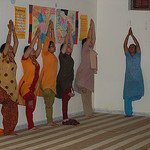We live in a culture in which we are often demanded to do more. How much writing can you do in a year/semester/week/hour? How many students can you teach effectively?
This constant striving for more leaves many of us feeling inadequate a lot of the time. It also privileges an approach to work that is about pushing, stretching, testing our limits to see if they can be extended. No wonder everyone is tired.
My approach has been heavily influenced by yoga.

My yoga teacher shared some interesting information. Apparently there is new research showing that if you stretch muscles beyond their comfortable range of movement, your brain kicks in with a protective response contracting them further to protect them. Contrary to what we once thought, that stretch does not result in an increased range of movement but may result in reduced range of movement, even if we are careful not to actively injure the muscle. (see, for example, Stretching Doesn’t Work the Way You Think It Does)
In response to this knowledge, she has been directing us to make smaller movements. To only go as far as we can go with the muscle relaxed. If we discover the limit by going a bit beyond it, to make that movement smaller on the next couple of repetitions to reassure our brains that the muscle is protected.
It is interesting how quickly the range of motion can be extended in this way. Initially it feels a bit weird, though, like you aren’t working hard enough.
The hardest part of working in this way is getting comfortable with the idea that effective work can be done in a relaxed state. We are so used to defining hard work as working right at the limits of our capacity and pushing those limits (even a little bit) that working within a comfortable range of motion feels lazy (at first). It takes a bit of practice and observation to notice just how effective it is.
My yoga teacher is pretty smart. She knows this is the hard part. This is one reason she actively directs us to make smaller movements, even the smallest possible movement.
How does this apply to your writing and writing practice?
We use analogies between physical work (work involving muscles) and intellectual work all the time. Although it doesn’t necessarily follow that intellectual work follows the same rules and patterns as physical work, it seems to be worth experimenting with.
This is why I encourage participants in A Meeting With Your Writing to work on the project and the task within that project that they most want to work on (for whatever reason). This is why I encourage you to identify how you’d like to feel why you are working and take concrete steps to help you feel that way as part of getting started (or returning to your work after a break or distraction).
This is also why I do not ask about how much you wrote, but ask instead “How did your project move forward?” reminding you that all movement is forward movement and that sometimes that movement looks like more words, sometimes it looks like better words, and sometimes it is much more abstract (something like “I think I know where this is going now.”).
This is also why I encourage you to observe the details related to your focus and attention, noticing if there are patterns in when you are in flow and when you get distracted. It is why I encourage you to plan your writing session to work with those patterns to optimize your focus.
How could you experiment with working in a relaxed state?
Related posts:
The benefits of working small : my further thoughts
Pressure vs ease in organizing your work (switching from yoga to cattle)
Post updated July 25, 2016, additional related post added August 24, 2017. Updated May 2025 to delete a related post that’s no longer available.








Leave a Reply